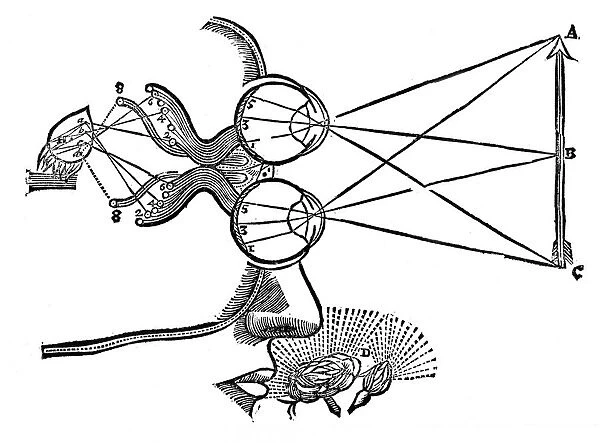Home > Europe > France > Paris > Opera
Descartes illustration of the co-ordination of the senses. Visual stimulus travelling
![]()

Wall Art and Photo Gifts from Universal Images Group (UIG)
Descartes illustration of the co-ordination of the senses. Visual stimulus travelling
Descartes illustration of the co-ordination of the senses. Visual stimulus travelling from the eye to the pineal gland, H, stops attention being given to olfactory stimulus. From Rene Descartes Opera Philosophica, Frankfurt-am-Main, 1692. Originally published in his Tractatus de homine, Paris, 1664. Woodcut
Universal Images Group (UIG) manages distribution for many leading specialist agencies worldwide
Media ID 9783163
© Universal History Archive/Universal Images Group
1692 Attention Co Ordination Descartes Frankfurt Am Main Gland Medicine Opera Originally Paris Philosophica Physiology Published Rene Senses Travelling Woodcut 1664 Olfactory Pineal Stimulus Stops Tractatus Visual
FEATURES IN THESE COLLECTIONS
> Europe
> France
> Paris
> Opera
> Universal Images Group (UIG)
> History
> Paris
EDITORS COMMENTS
This print showcases an intriguing illustration by Rene Descartes, depicting the coordination of the senses. Dating back to 1664 and originally published in his renowned work "Tractatus de homine" this woodcut engraving offers a glimpse into Descartes' exploration of human physiology. In this visual representation, we witness the journey of a visual stimulus as it travels from the eye to the pineal gland (marked as H). Interestingly, Descartes highlights how this process diverts attention away from olfactory stimuli. The intricate interplay between our senses is beautifully depicted through this artwork. The significance of Descartes' illustration lies in its contribution to both medicine and philosophy. It serves as a testament to his groundbreaking ideas on sensory perception and cognition. By emphasizing the role of the pineal gland in processing visual information, he challenged traditional beliefs about sensory integration. Dating back over three centuries ago, this woodcut engraving has stood the test of time and continues to captivate audiences today. Its inclusion in Descartes' Opera Philosophica further solidifies its importance within scientific discourse. As we delve into this thought-provoking image, let us appreciate how it symbolizes humanity's eternal quest for understanding ourselves and our complex relationship with the world around us.
MADE IN THE USA
Safe Shipping with 30 Day Money Back Guarantee
FREE PERSONALISATION*
We are proud to offer a range of customisation features including Personalised Captions, Color Filters and Picture Zoom Tools
SECURE PAYMENTS
We happily accept a wide range of payment options so you can pay for the things you need in the way that is most convenient for you
* Options may vary by product and licensing agreement. Zoomed Pictures can be adjusted in the Cart.

